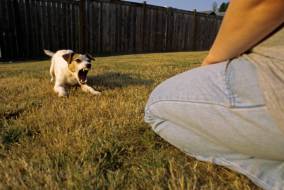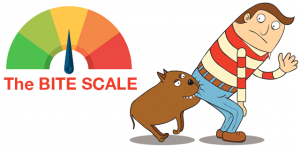The question of whether to put a dog down or not after it has badly injured someone in an attack is an emotional one. There are strong opinions on each side. Some say that a dog who bites once, no matter the severity of the bite, or the context, should automatically be euthanized. Then there are those who believe that all dogs should be saved, no matter how badly they’ve injured someone. There are also those who forgive certain breeds who bite, while condemning certain dogs due to their breed.
The size of the dog also affects people’s reactions to bites as well. Many bites from small dogs go unreported, while larger dogs who bite, get reported more often. Regardless of the severity of the bite. We are also all aware of how certain breeds who have been stigmatized often face devastating consequences regardless of context or severity of a bite.
A lot of people believe that if a dog is aggressive, or has attacked someone that it’s the owner’s fault, in that the owner has either made the dog aggressive, or hasn’t raised it properly. That it’s not the dog’s fault. You often hear people claim that it’s all in how the dog was raised.
Many believe that if you change the dog’s environment, or owner, and if you love it enough, that it will be a good, safe dog. While this may be true in some cases, there are many factors to consider when it comes to the outcome of a dog who has attacked or bitten someone.
While context should be taken into account, the severity of the bite(s) is what definitely needs to be taken more seriously. A dog who shows good bite inhibition, meaning the dog who uses very little force with its bite, has a better prognosis than those who use the full force of their jaws when they bite. Poor bite inhibition also results in more serious injuries. Where injuries occur on the body matters as well, as does the size and age of the victim. A bite to a child or a baby may be more severe than if the dog had bitten a large adult in the same area of the body.
Dogs can bite with varying degrees of force. Any dog, no matter their size or breed has the potential to kill. Every dog, be it your dog, or my dog, has the potential to bite, given the right circumstances. Many people are shocked when I say this. They claim that their dog would never, ever bite someone. But if a dog is in enough pain, or feels threatened enough, it may bite.
When dealing with a dog who has bitten someone, the severity of the bite, or the bite level should be a huge consideration regarding the future of the dog. Dr Ian Dunbar’s Bite Scale Assessment allows us to objectively determine how dangerous a dog really is. It also helps us determine how easily a dog can be rehabilitated, if at all.
Bite Scale Assessment
Level 1: Dog may lunge, snarl, growl, or air snap. Often referred to as a pre bite. The dogs’ teeth don’t make contact with the skin, even though the dog showed aggressive behavior.
Level 2: Dogs’ teeth makes contact with skin, but there is no actual puncture. Often referred to a near bite, or a highly inhibited bite. There may be redness or bruising, or scratches to the skin.
Level 3a: One to four punctures of skin, less than half the length of the canine (eye) tooth. A single bite, which is usually a quick bite and release.
Level 3b: Same as level 3a, though with multiple bites, in rapid succession. Levels a and b may leave bruising and abrasions.
Level 4: One to four punctures from a single bite, with more than half of the length of a canine tooth. Punctures often due to canine teeth, though punctures may result from other teeth as well. Tearing of skin and/or dark bruising is present. Possible bone break. Dog clamped down and shook its head.
Level 5: Multiple level 4 bites. Deep punctures. Tearing of skin and/or muscle tissue. Possible breaking of bones. A serious attack.
Level 6: The dog attack or bite(s) results in death.
Over 90% of dog bites thankfully fall under Level 1 or Level 2. Since there isn’t any hospital requirement, these bites are rarely reported. Especially if committed by a small breed dog. In many Level 1 bite situations, the owners or victim claims that the dog tried to bite them, insinuating that their fast reflexes saved them from an actual bite. This often isn’t the case though. Dogs can move their heads four times faster than a human can move their hand, and dogs can land four bites in one second. You are never faster than a dog who is trying to bite. Ever.
Dogs with Level 1 or 2 bites also show very good bite inhibition, which leads to a positive outcome with some training and behaviour modification. Though I understand an owners’ fear when their dog bites someone, especially a child, I am sad when these dogs get put to sleep, as these dogs are able to be helped, so long as owners are willing to put in the work required.
Low level aggressive behaviour such as this shouldn’t be punished though, as this may often exasperate the behaviour. Dogs will rarely bite if a warning will do, but the more the dog engages in the behaviour, the stronger that behaviour will become. Dogs who are punished for warning behaviours sometimes jump the aggression ladder and move straight to a bite. Sometimes in what may appear to be, out of the blue. Best to work with a dog giving warning signs before the dog feels the need to actually bite.
Dogs who bite at level 3a and 3b should always be considered a liability, even after behaviour modification. Dogs who give repeated level 3 bites are usually in higher states of arousal, and aren’t thinking but are just reacting between bites. These dogs may be improved up to 99.9%, but it is critical that owners learn dog body language, as well as their dogs’ triggers to be aware once the dog is becoming upset, and are then able to react to avoid a bite. It becomes the owners’ responsibility to ensure that the dog is never put in a situation where it may bite. Even if the dog learns to have a softer mouth through behaviour modification, once highly aroused or scared, they will often revert to their initial bite inhibition level when biting.
Dogs who bite at level 4 and level 5 are serious liabilities. Bites at these levels can kill a child, and shows no bite inhibition. These dogs often have a lot of practice of giving lower level bites, and usually have an established bite history. Dogs who bite at this level or higher often have a poor prognosis, even with behaviour modification, as they will resort to this bite level when highly aroused or scared.
With dogs who bite at level 5, euthanasia should be highly considered as a possibility. Yes, the dog can wear a muzzle 24/7, but management only works until it doesn’t. Their bite inhibition is non existent and these dogs are dangerous. This is obviously true of a dog who commits a level 6 bite as well. Regardless of context, this bite level is just too dangerous.
Even though most dogs are great dogs, and most dog bites aren’t terribly serious, not all dogs can be, or sadly, should be saved. An emotional topic indeed. What do you think? Do you believe that all dogs can be saved? We welcome your comments below.
 Montreal Dog Blog Montreal's Online Dog Park
Montreal Dog Blog Montreal's Online Dog Park






